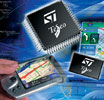

STMicroelectronics has launched volume production of its Teseo GPS engine designed for use in certain Garmin portable navigation devices (PNDs) and handheld GPS receivers.
The Teseo platform is a turn-key solution that combines reliability and cost-effectiveness with enhanced performance and extended functionality.
Superior tracking sensitivity is vital for portable navigation devices that have the antenna inside and their satellite visibility is further deteriorated by the 'shield effect' of the car front window. The integration of ST's newest GPS solution improves tracking in poor satellite visibility conditions and shortens GPS signal acquisition times.
Teseo's TTFF (time to first fix) values, the time it takes a GPS receiver to find satellites, rank among the fastest in the industry. A 'warm start' - the acquisition of accurate time, satellite positioning and velocity data that have been lost during the switch-off - takes less than 34 seconds.
ST's new GPS chipsets support satellite-based augmentation systems such as WAAS (wide area augmentation system) and EGNOS (European Geostationary Navigation Overlay Service) that provide additional accuracy and reliability. Teseo's GPS accuracy expressed in circular error probability (the radius of a circle that represents a 50% probability of a position lying in that circle) is as low as 2 metres. Teseo devices are ready for compliance with Galileo, the upcoming European navigation system complementary to GPS.
The Teseo solution integrates a high-sensitivity single-chip baseband (STA2058) with embedded flash and an RF front-end (STA5620), complemented with full software libraries. The product is available both in a single-package form (STA8058) and as a dual-chip offering.
The embedded Flash memory enables the equipment manufacturer to load the entire GPS software. The Teseo GPS baseband IC integrates a rich set of peripherals, including a CAN 2.0 B active interface, a four-channel 12-bit A/D, I²C, UART, SPI, GPIO and USB.
For more information contact Larry Gordon, Arrow Altech Distribution, +27 (0)11 923 9600, [email protected], www.arrow.altech.co.za, Avnet Kopp, +27 (0)11 809 6100, [email protected], www.avnet.co.za
| Tel: | +27 11 923 9600 |
| Email: | [email protected] |
| www: | www.altronarrow.com |
| Articles: | More information and articles about Altron Arrow |

© Technews Publishing (Pty) Ltd | All Rights Reserved